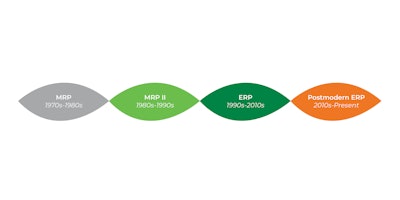
Postmodern ERP is the latest iteration of Gartner’s thinking on the best strategies to be adopted when implementing enterprise-wide solutions. It’s a response to the inexorable rise of the monolithic single vendor, single solution approach that has resulted in a number of high-profile failures with massive hits to both bottom lines and reputations. ER
In 2014, Gartner defined Postmodern ERP as “a technology strategy that automates and links administrative and operational business capabilities with appropriate levels of integration that balance the benefits of vendor-delivered integration against business flexibility and agility”.
This latest evolution is a recognition that ERP solutions can be great for core business administrative functions such as HR, finance, payroll, etc. However, across large organizations there is normally a variety of diverse business models that need custom solutions that closely address their unique operational needs. The result will usually be a trade-off between overall operational efficiency versus business flexibility and agility.
Postmodern ERP is not a platform or set of tools. It is a strategic approach that recognizes that every agribusiness is unique and needs to formulate a strategy based on their specific needs. The overall strategy will be a combination of two different sub-strategies that address both administrative and operation requirements separately.
Integrations are key
Successful postmodern ERP is dependent upon the integration capabilities of the various components and a key consideration during the selection process. The integrations are normally the most complex and challenging aspects of any postmodern ERP strategy and can involve coordinating effort across multiple internal teams and external vendors.
However, the main reason monolithic ERP implementations often do not succeed is a failure to address the impact of (and resistance to) changing long established business practices and cultures. By leaving these unchanged and moving the challenges to the software integrations, this is something addressable by IT without any significant impact on the operational business users.
What should be done
We have observed first-hand the challenges faced by our enterprise agribusinesses customers and their attempts to address them. Several have learned the hard way that implementing a company-wide monolithic ERP usually comes down to a fundamental choice between the high cost of tailoring ERP software to address multiple often conflicting requirements, or changing long established business processes and cultures to work the way the software does. Neither is an attractive or straightforward option.
We recognize there is not a “one size fits all” solution, especially in the agri-food sector. When monolithic ERP is already up and running in an organization but not going well, considering switching to a postmodern ERP strategy may not be the best approach. In this case, the recommendation is often to address the known problems in the current ERP rather than creating a whole new set of unknowns.
Conversely, other than the large ERP vendors themselves, no one in today’s challenging business climate would recommend implementing a single monolithic ERP solution unless their client is in a stable and established marketplace where the agility to support rapid growth or adapt to changing market conditions is not a requirement.
Stephen Berry is the lead software architect at Cultura Technologies, a family of agri-food software companies operating across North America and Europe.










